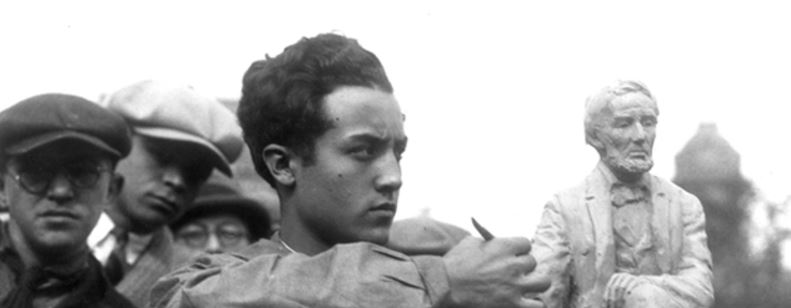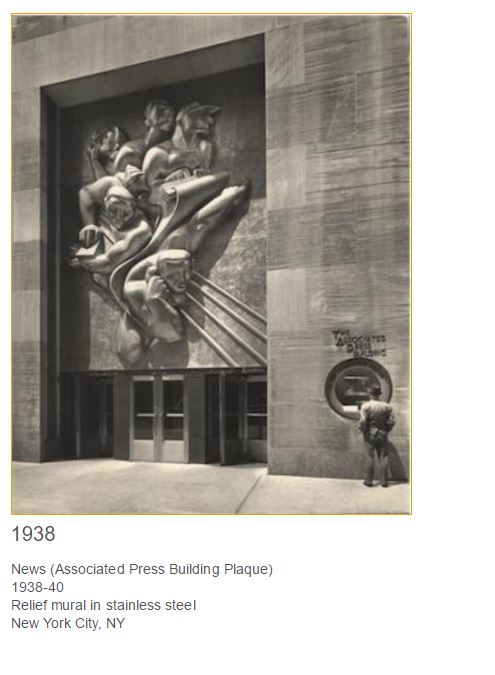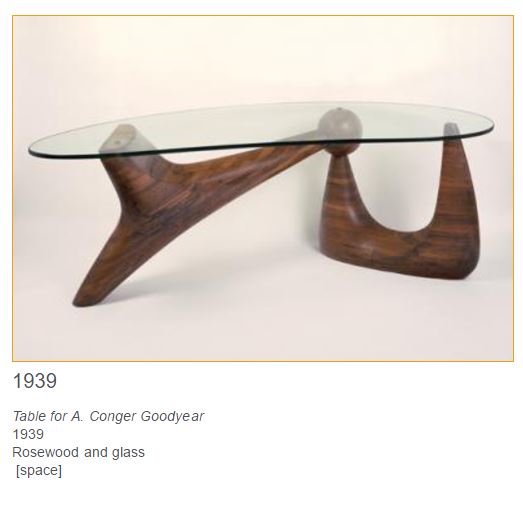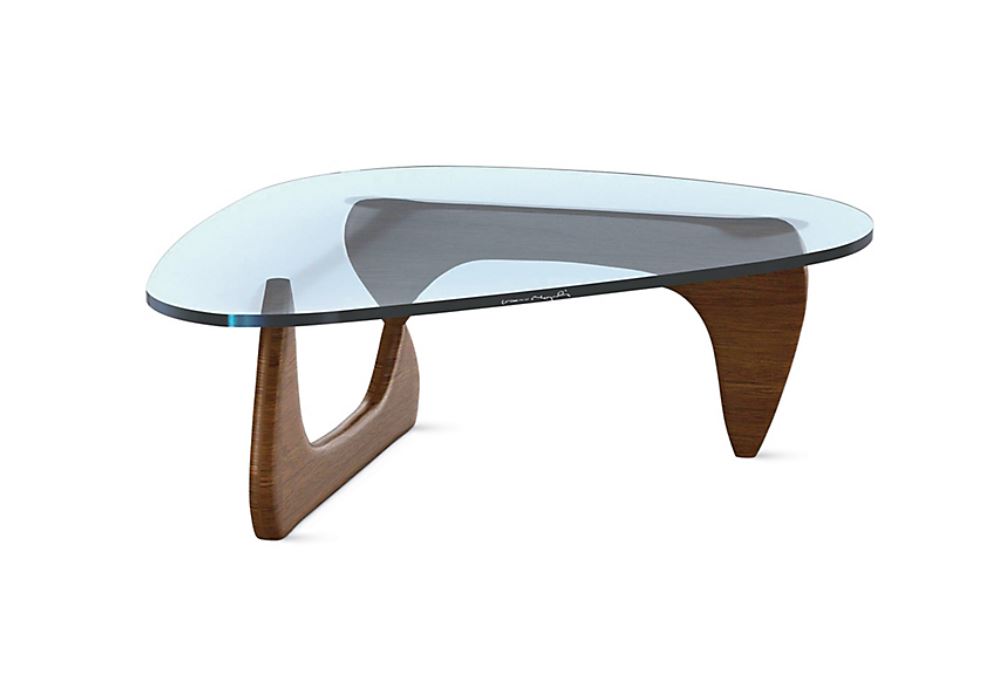
Isamu Noguchi (1904–1988) was one of the twentieth century’s most important and critically acclaimed sculptors. His work has transcended generations and crossed several aesthetic boundaries. His “simple” coffee table form has been a source of inspiration for many and has often been duplicated, reproduced, and knocked off for over half a century. In modern interiors, the Noguchi table is a household icon and today perhaps his most recognized work.
Through a lifetime of artistic experimentation, he created sculptures, gardens, furniture and lighting designs, ceramics, architecture, and set designs. His work, at once subtle and bold, traditional and modern, set a new standard for the reintegration of the arts.
Noguchi traveled extensively throughout his life. (In his later years he maintained studios both in Japan and New York.) He discovered the impact of large-scale public works in Mexico, earthy ceramics and tranquil gardens in Japan, subtle ink-brush techniques in China, and the purity of marble in Italy. He incorporated all of these impressions into his work, which utilized a wide range of materials, including stainless steel, marble, cast iron, balsa wood, bronze, sheet aluminum, basalt, granite, and water. As a young man, he interned with Gutzon Borglum, the sculptor of Mount Rushmore.
A few years later, he moved to New York and enrolled in pre-medical studies at Columbia University before devoting himself to sculpture in 1926. He scavenged his New York neighborhood for materials he could use for his sculptures and other projects. At one time, Noguchi was creating a table for his sister. The prototype Noguchi was working on was made from materials he had picked up in alleys and on the street.
In 1938 Noguchi was awarded his first major commission at Rockefeller Center which was awarded via an open contest. The grandiose bas-relief sculpture titled News, stands above the entrance to what was originally the Associated Press Building. (The building’s anchor tenant is now Bank of America; the Associated Press, the wire service that continues to provide its services digitally and otherwise, relocated out of Rockefeller Center in 2004). Unveiled in 1940, News depicts five newsmen getting the scoop through traditional, analog methods: with a camera, over the wire, on the telephone, via a teletype machine and with “good ol’ pen and paper.”

While “News” is an Art Deco piece, Isamu was interested in creating organic modern forms.
Shortly thereafter, Noguchi designed his first table in glass and wood for A. Conger Goodyear, president of the Museum of Modern Art. MOMA is another Rockefeller creation as Abby Aldrich Rockefeller (wife of John D. Rockefeller Jr.) was one of the founders. Abby had invited A. Conger Goodyear, the former president of the board of trustees of the Albright Art Gallery, to become president of the new museum. I’ll write more about the powerful Rockefeller influence in future blog posts – especially their influence right here in the Rivertowns.

Post war modernism was leaning more towards curved organic forms. Leading American furniture designers too were inspired by organic, amoeboid forms. The curved forms of the new furniture were first seen at the Museum of Modern Art in 1940 as part of the ‘Organic Design in Home Furnishings’ competition. Designers trained at the Cranbrook Academy in Bloomfield Hills, Michigan, were now producing furniture which challenged European dominance. Founded in 1932 and managed by the Finnish architect Eliel Saarinen, Cranbrook trained a generation of important designers, including the well known Charles and Ray Eames and Harry Bertoia.
The Cranbrook designers regarded mass production in a positive light as bringing “good design” to the mass market. Similar to the German’s “Beidermeier” era, which translates to “every man.” Quite the opposite of the philosophy of the Arts & Crafts movement which I often write about. Herman Miller produced, and still produces, leading examples of modern furniture designed by sculptors, including Isamu Noguchi’s design for a palette shaped glass topped table (Coffee Table, 1944).

Isamu Noguchi: Table for Herman Miller, 1944. An early example of post-war Modernism. Noguchi’s inspiration was the art of Japan, where the sculptor had spent his childhood.
The table is just three pieces. A ¾-inch freeform glass top rests on two curved, solid wood legs that interlock to form a self-stabilizing tripod. “Although it looks delicate, it is solid, perfectly balanced, durable. There are few tables in the world of interior and industrial design with the staying power of the Noguchi Table, but advances in taste, style, and aesthetic possibility have never dislodged the table from the popular mind, or popular wish lists,” says the Herman Miller store.
The Noguchi Table is, ironically, not quite what its creator expected it to be. According to Herman Miller, it was Noguchi’s belief that design should disappear into the environment, that it should merge into its surroundings. While the table is certainly calm and organic, it’s impossible for a design as stunningly well-executed as it is to disappear into anything, much less into the same mold as what surrounds it, yet this table stands out like any great piece of sculpture does – even if it is against its own even-tempered will.
How do you know if your table is a fake?
Because the Noguchi Table is so popular, there have been a number of knock-offs. Herman Miller is the only company that has the manufacturing rights and they place stamps in two places with unmistakable seals of approval. Along the longest side of the three quarter inch thick pane of glass, you can see the signature of Isamu Noguchi, secured for Herman Miller through the offices and urgings of the Noguchi Foundation. All genuine Noguchi tables made after January 20, 2003 have this signature. Also in place since January 20, 2003, there is another marker that proves the authenticity of the table. On the underside of the base, there is a medallion. Underneath that medallion, you will find another signature of the creator.
By Melissa Colabella
Sources:
Noguchi.org
HermanMiller.com
RockefellerCenter.com
Interior Design Since 1900, 3rd Edition, by Anne Massey, Thames & Hudson World of Art
